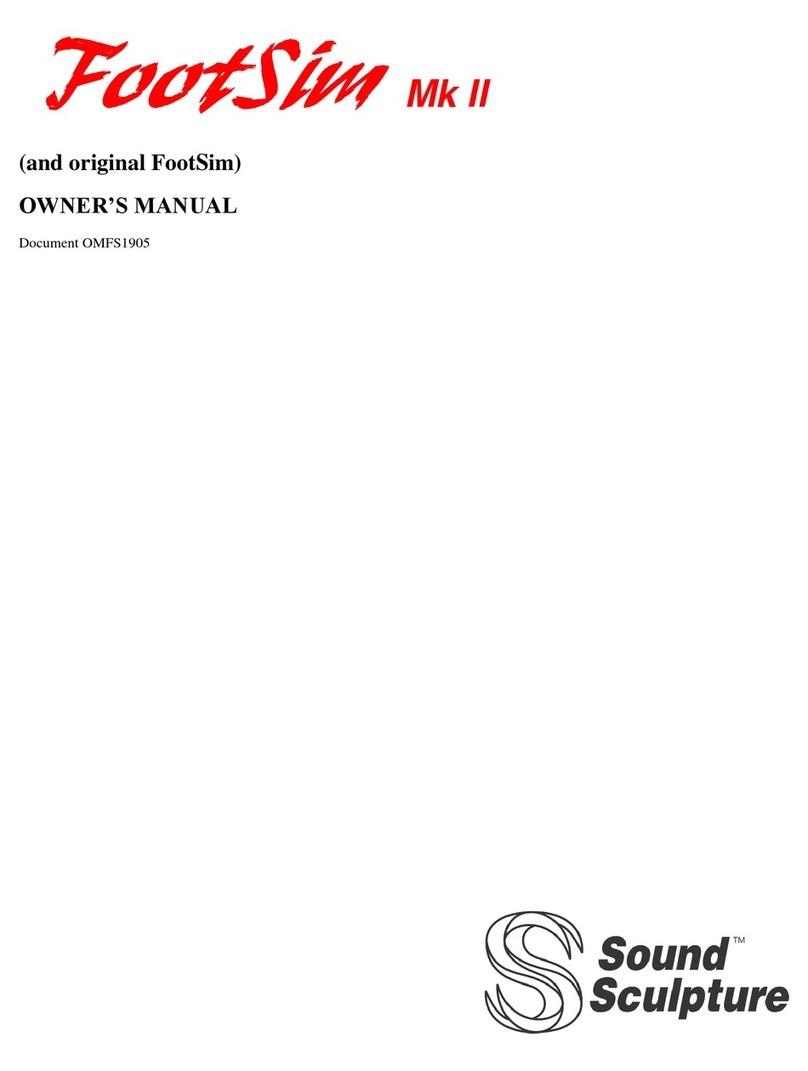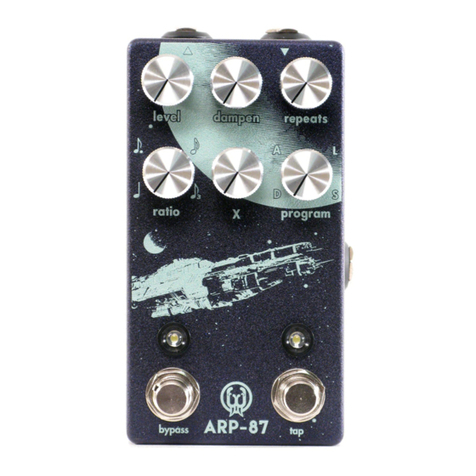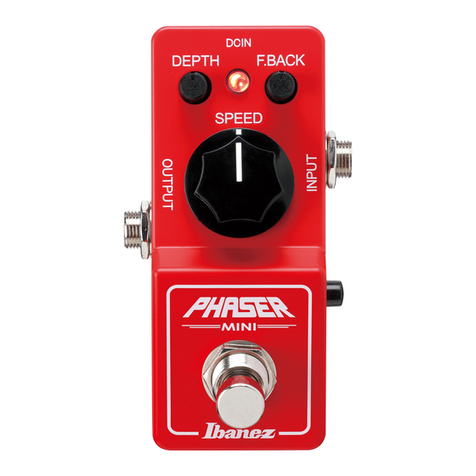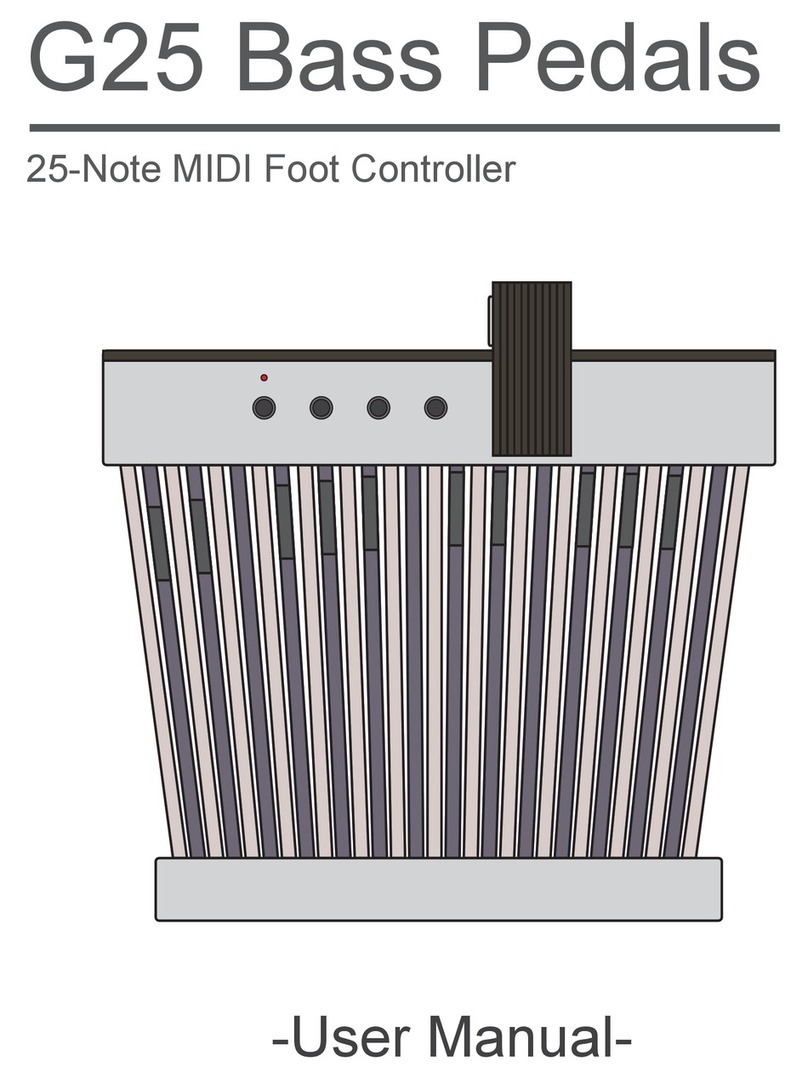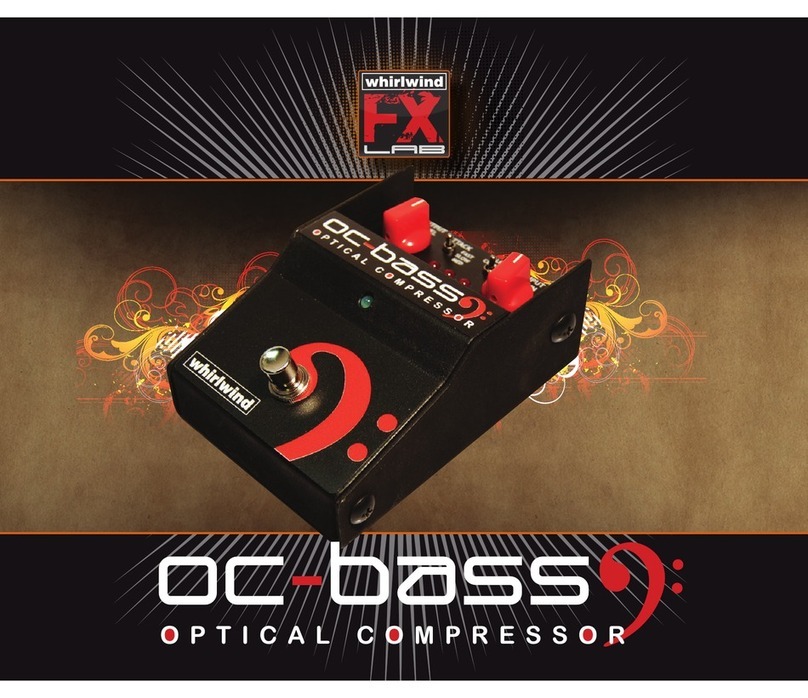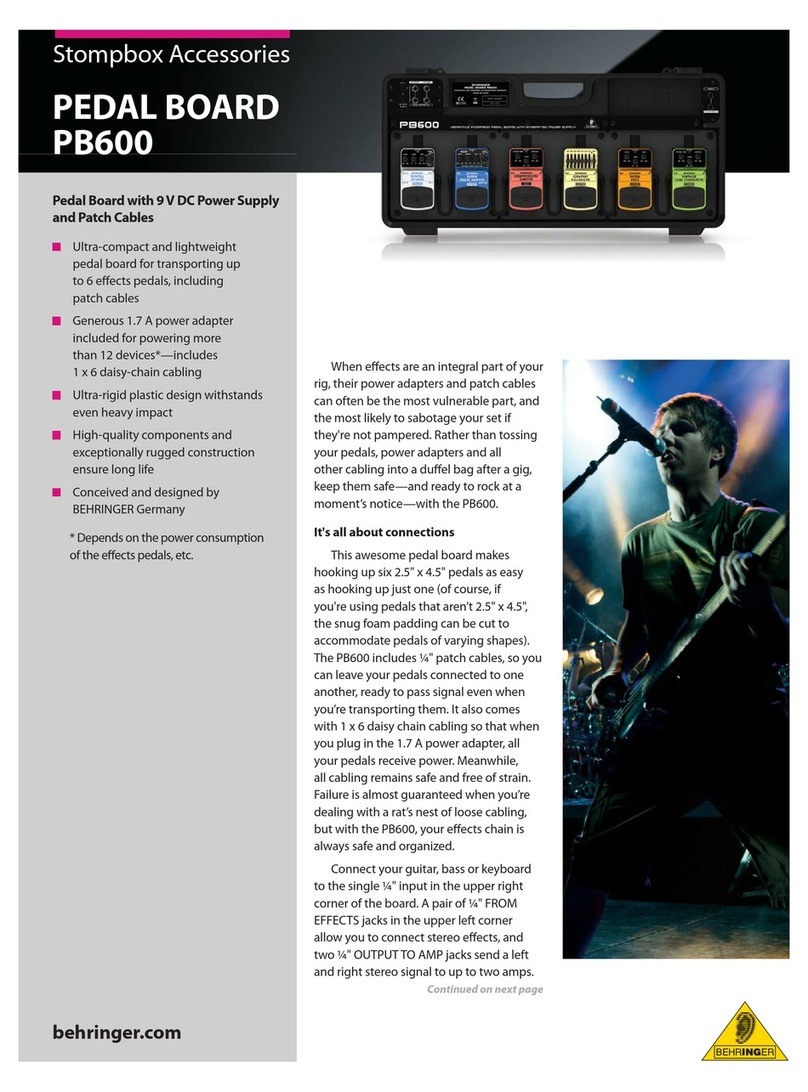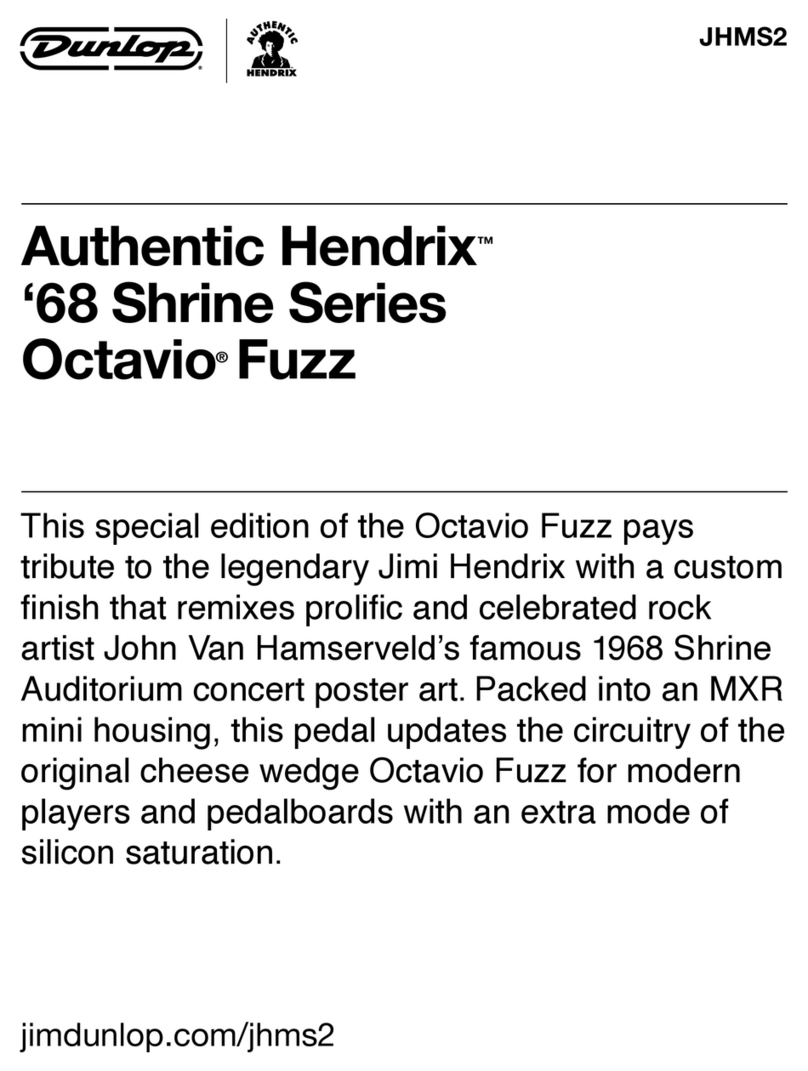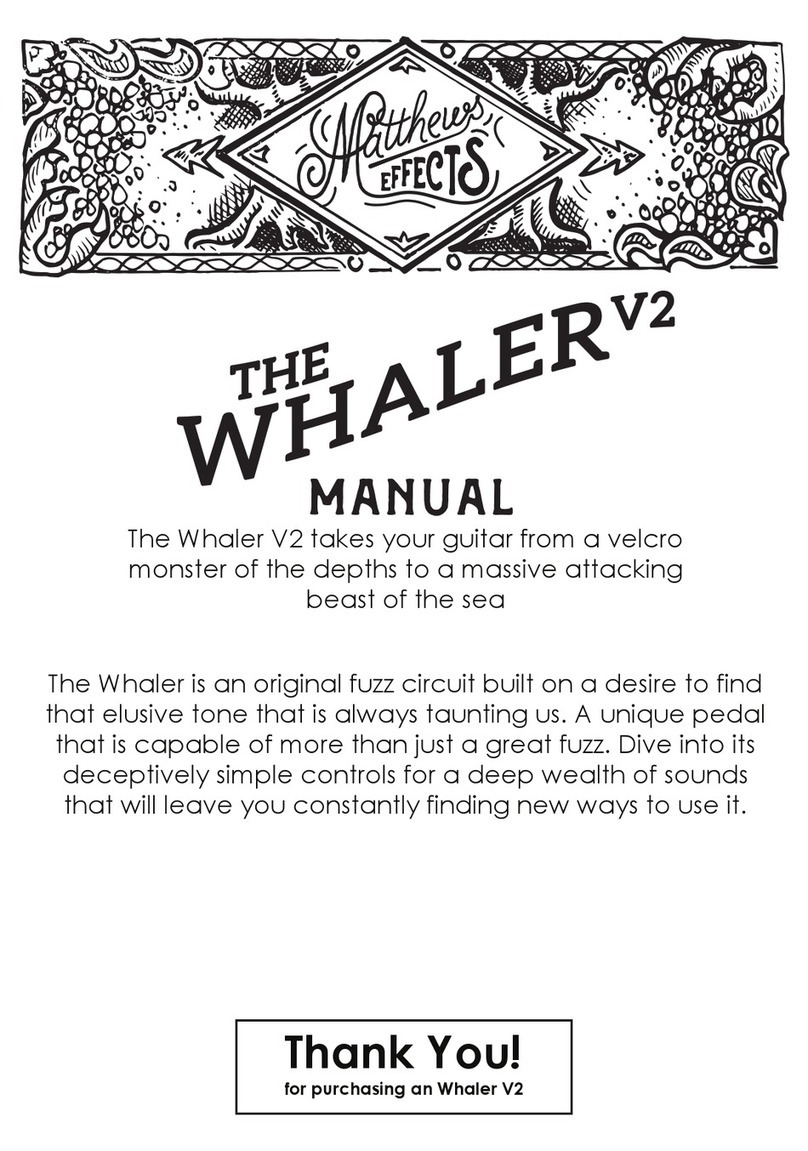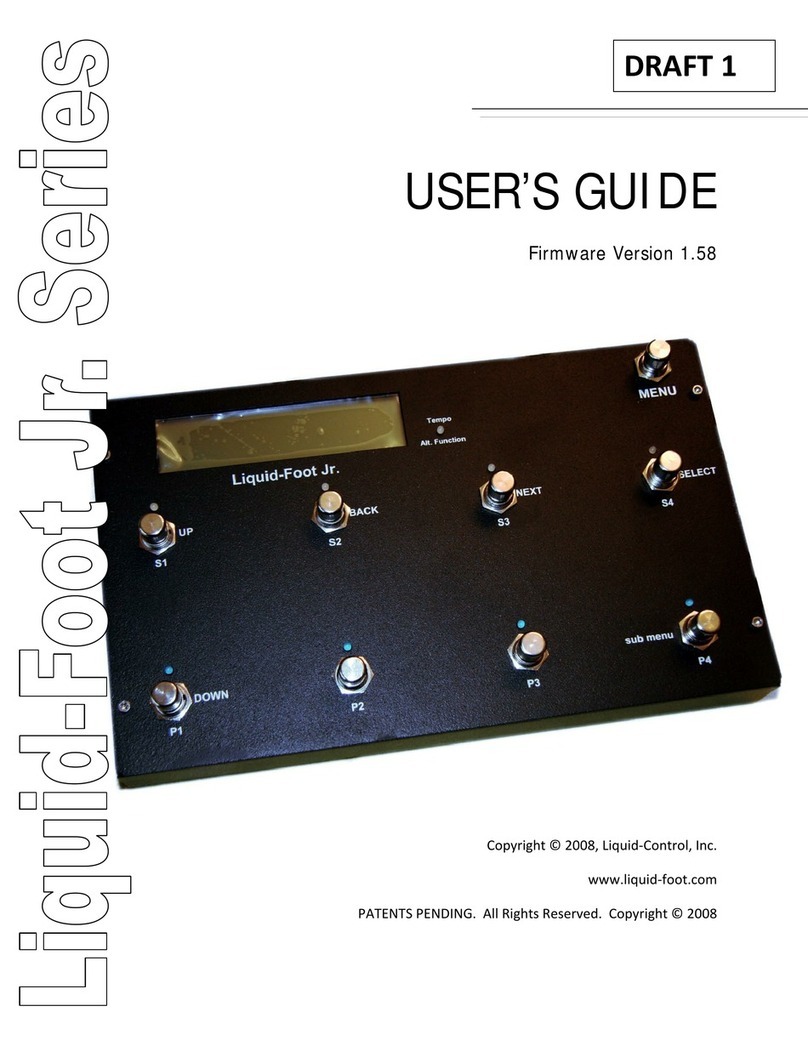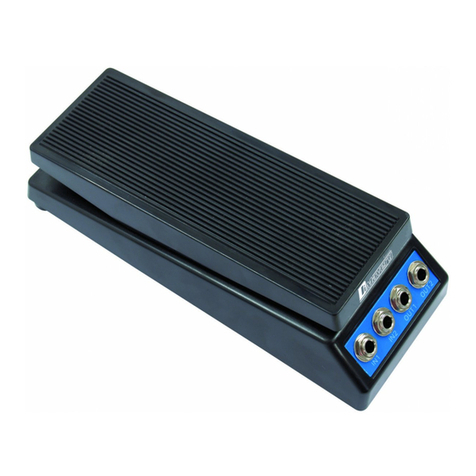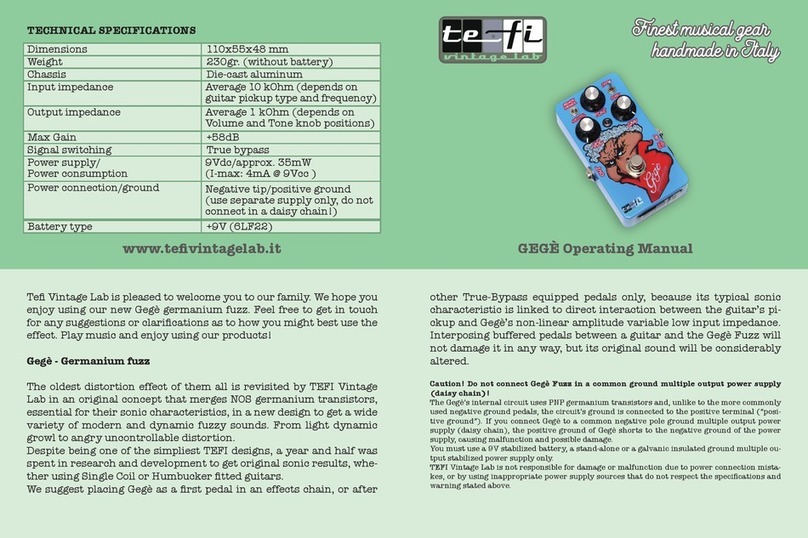Sound Sculpture Volcan User manual

Volcano
MIDI and Expression Pedal Controlled Volume

1
Thank you for purchasing the Volcano remotely controlled volume control. Take a look at some of the reasons this is
the best volume effect you will ever use.
The Volcano is an all analog effect containing an ultra high quality audio channel allowing gain changes in an audio
path under MIDI Control Change or Program Change messages or directly from an expression pedal connected to the
pedal input. Because of the unique approach to the design of the Volcano, the audio quality is superior to its typical
counterparts especially with regard to noise, transparency, accuracy, flexibility and size.
The Volcano can be used as a remote volume pedal without the need for MIDI simply by connecting an expression
pedal. The range of the pedal can be set to commonly used ranges using a selector switch inside the unit. Multiple units
can be connected via MIDI cables and these units will track the expression pedal connected to the first unit
automatically.
The Volcano can be controlled by MIDI messages from your favorite foot controller or computer. Using MIDI the gain
can be set to a vast range of fixed gains, or a range of gains that can be controlled by a MIDI continuous control pedal or
from the expression pedal input. Advanced commands such as Softchange will quickly and quietly switch gains on the
Volcano even while playing without the spikes heard in other systems.
Audio Quality: Unlike all other effects of this type, the Volcano does not use any voltage controlled amplifiers (VCAs).
VCA systems tend to be noisy and have excessive distortion and can block the natural tone of your instrument. The
Volcano takes an entirely new and different approach to signal level control that depends strictly on rapidly selecting
various resistances to control gain. Using resistors to change gain is simply the cleanest, purest method of controlling
signal levels and results in a crisp, transparent tone from your guitar, keyboard, vocals or other instruments. In addition,
a high quality low distortion/high transparency input and output buffer are included in the Volcano to keep your
instrument signal as clean as possible. In a nutshell, your signal goes through nothing more than an input buffer, a
resistor selector circuit, and an output buffer for absolutely the cleanest possible signal available. For an added measure
of quality and to insure the lowest possible noise levels a balanced (differential) internal signal path is used.
No Lag: The response to gain changes from movement of the expression pedal or from a CC or Program message is
virtually instant with no lag in response time.
Accuracy: Since the volcano uses precision resistors to select gains, the selected gains are repeatable and accurate.
When you select a 12dB boost on the Volcano, you get just that, exactly 12dB of boost regardless of temperature,
humidity, or age. This results in a repeatable performance time after time. For added convenience a yellow/red
indication is also offered for check for potential overload conditions.
Precision Zero Cross Detect: For the lowest possible distortion and to eliminate zippering noise the gain of an audio
signal should be changed only during the point at which audio passes through zero. The Volcano incorporates a
hardware based ultra precision zero crossing detection scheme which is used during all volume changes which results in
very natural sounding volume changes and lowest distortion during sweeping.
The Volume Effect: The Volcano can vary the level of a signal in real time from -72dB to +18dB (when set to
instrument level) or from -84dB to +6dB (when set to line level) including mute in approximate 1/3 dB increments. Since
the level is controlled exclusively by MIDI messages or by an expression pedal connected directly to the unit, the
Volcano can be used as a remotely controlled volume pedal where the Volcano can be placed near the signal path while
being controlled remotely by a pedal that is not part of the audio signal. This has the great advantage of achieving the
lowest noise, highest purity, and highest reliability.Instant changes to the signal level can also be achieved by sending a
Program message or on/off type Control Change messages to the Volcano.

2
GETTING STARTED
If you do not yet have a power supply for the Volcano, you will need to choose one. See "POWERING THE VOLCANO" in
the appendix for details on this.
If you plan on using the Volcano with MIDI (and will not be using a locally attached expression pedal), then follow the
steps in "QUICK START (MIDI)". If you will not be using MIDI and want to use only an expression pedal connected
directly to the Volcano, then follow "QUICK START (EXPRESSION PEDAL ONLY)". If you plan on using both, then follow
the steps in "QUICK START (MIDI)" but also calibrate the expression pedal as directed in the appendix.
QUICK START (MIDI)
(Note: The Volcano is factory set to MIDI channel 1 and instrument level and will power up in mute awaiting MIDI
commands)
1. Attach your MIDI controller to the MIDI in port of the Volcano
2. Set a program switch on your controller to transmit Program Change message #53 (for controllers that start their
Program numbers at 0) or #54 (for controllers that start at 1) over MIDI channel #1
3. Assign your movable MIDI controller (which we will refer to in the future as the CC pedal) to Control Change #0 over
channel #1. (again, if you controller starts its controller numbers at 1 instead of zero, use controller 1 instead).
4. Connect your instrument to the IN jack and your amp to the OUT jack of the Volcano.
5. Press the program switch on the MIDI controller, the DATA LED will blink indicating is has gotten a program
message.
6. Move the controller pedal to sweep the gain from OFF to +18dB of gain. The Status LED will shine red when the
pedal is full back and green when it is full forward.
7. If the unit does not blink when it sees the MIDI Program Message, then unit may be set to the wrong MIDI channel
(the unit is factory set to channel 1). See the appendix to instructions on how to set the MIDI channel.
QUICK START (EXPRESSION PEDAL ONLY)
When using an expression or volume pedal with the Volcano for the very first time, the Volcano must be calibrated to
the pedal to get the full range out of the pedal. Follow the instructions CALIBRATING THE EXPRESSION PEDAL in the
appendix to calibrate your pedal and go to step 2 before closing the unit.
1. Check that the remaining switches are set as follows. Switches 1-4 to OFF,OFF,ON,ON (local program for full pedal
range), the LOCAL/MIDI switch to LOCAL, and the LINE/INSTRUMENT switch to INSTRUMENT.
2. Connect your instrument to the IN jack and your amp to the OUT jack of the Volcano.
3. Move the expression pedal to sweep the gain from OFF to +18dB of gain. The Status LED will shine red when the
pedal is back and green when it is forward.
GENERAL THEORY OF OPERATION
The Volcano operates in two user selected modes, local mode and MIDI mode. Your intended application will
determine what mode the unit operates in. The mode is determined by the position of the LOCAL/MIDI switch inside
the unit.
Local mode is selected when you wish to operate the unit with just an expression pedal attached. No MIDI controller is
required to operate the unit in this mode. A bank of 4 switches inside the unit are set to select one of 16 different
programs. These programs are used to select a specific gain range when the pedal is moved. There are also 4 special
programs: a pan program, a custom curve program, a program to force the unit to output a CC message when the pedal
is moved and a program to force the unit to go into a "slave" mode where is will perfectly track any Volcano connected
to its MIDI input. This last program is useful if you wish to have several Volcanoes connected together and want to
control them all with just a single expression pedal attached to the first "master" unit.

3
MIDI mode is selected when you wish to control the unit with a MIDI controller or a computer. In this mode the unit will
accept Program Change messages (to select various programs such as fixed gains or pedal ranges), Control Change
messages in "instant access" form (to enable/disable certain functions such as bypass, mute, or boost), or Control
Change #0 as a message from a moving pedal (to sweep the gain) .
MIDI mode and the expression pedal: In MIDI mode the unit responds to both CC #0 message and the expression pedal
to sweep the gain. This is a great convenience if you have a MIDI pedal far away from the unit and an expression pedal
close to the unit and want to use one or the other without missing a beat. If one pedal is used, and the user switches
over to the other pedal, the new pedal must move through the position of the original pedal before it takes control of
the gain to insure that there is no abrupt jump in the gain. With this feature both pedals operate as smoothly as if there
were just one pedal.
UNDERSTANDING THE SWITCH SETTINGS
Inside the Volcano is a 7 position selector switch used to set various parameters in the Volcano. The switch is accessed
by removing the 2 screws on the front panel and sliding the unit out until the switches are visible. The switch functions
are described here:
The LINE(+4dB)/INSTRUMENT(-10dB) switch is used to change the
headroom range of the unit to accommodate either line level signals
or instrument level signals. When set to LINE the input can accept
12dB more of signal at the input before overload than it can in the
INSTRUMENT setting, but also limits the amount of available boost in
the programs to +6dB. When set to instrument the input can accept
all instrument level signals and can even accept lower line level
signals before overload and has the advantage of allowing up to
18dB of boost.
If you are planning on using the Volcano between the guitar and amp, or even in most amp effect loops, the
INSTRUMENT setting is the best because of the extra boost offered. If you are using the unit with a very hot effect loop,
or after high level line effects where the extra boost is not needed but the extra input headroom is needed, then the
LINE setting is best. Either setting works perfectly fine for an instrument such as a guitar and the choice when used this
way is determined by the maximum boost the user needs.
The MIDI/LOCAL switch is used to set the unit to MIDI mode or to LOCAL mode as described earlier. The setting of this
switch also determines whether the 4 switches (labeled 8-4-2-1) determine the MIDI channel number (when in MIDI
mode) or the local program (when in LOCAL mode).
Switches 8-4-2-1:
When in MIDI mode these switches will set the MIDI channel number. The values 8-4-2-1 indicate the summing weight
of the switch (where 8 adds 8 to the channel number and so on). Refer to the MIDI Channel Switch Chart in the
appendix to determine the switch setting for various channels. All switches off set the unit to channel 1 and all switches
on set the unit to channel 16.
When the switch is set to LOCAL mode, then the switches determine the local program. See SETTING THE LOCAL
PROGRAM to see the programs available and what they do.
The CALIBRATE/NORMAL switch is used only once when a new expression pedal is first matched up to the volcano in
order to take advantage of the full sweep range of the pedal and to be able to use almost any type of expression pedal
or volume pedal with the Volcano. See the appendix for detailed instructions on how to calibrate a pedal.

4
SETTING THE LOCAL PROGRAM
In LOCAL mode (LOCAL/MIDI switch set to LOCAL) the Volcano will respond to the movement of the expression pedal
attached to the expression pedal input according to the setting of the local program set by the 4 switches (labeled 8 4 2
1). Refer to the chart below to select a local program. The programs are described here:
Program 1 sets the Volcano in "slave" mode and is only used when you use two or more Volcanoes together. Connect
another Volcano's MIDI out to the MIDI in of this unit. No expression pedal is connected to a Volcano when it is in slave
mode as all gain is controlled solely by the "master" unit. All additional units after this one are also set to slave mode. If
the switch is set to any other program except program 1, it will always be a master and will always transmit a sync signal
to any connected slave units.
Programs 2-5 set the sweep from OFF when the pedal is full back to several different end gains when the pedal is full
forward. This is similar to a traditional volume pedal except you have your choice of how much gain you have when at
the end of the travel. The final gain is determined by the LINE/INSTRUMENT setting. The program numbers for
instrument settings are shown in parentheses. For example program 3 goes from OFF to 0dB when in LINE mode, but
the same program (shown as (3) ) goes from OFF to +12dB due to the extra 12dB of boost when in INSTRUMENT mode.
Programs 6-13 are similar to 2-5 but offer different starting (back pedal) gains. These limited ranges are useful if you do
not want to go entirely to mute but would rather have more control over a more limited range.
Program 14 is used only when 2 Volcano units are used together in a master/slave configuration (slave unit program set
to program 1) to allow panning of a signal to two amplifiers. Connect an instrument to the inputs of both units using a
'Y' cord or other similar splitter and connect the outputs to two amplifiers. The expression pedal connected to the
master causes both units to operate together to pan the signal. The LINE/INSTRUMENT switch should be set the same in
both units to offer either a 0dB or +12dB output while panning.
Program 15 uses custom curve 1 (same curve as custom curve 1 in MIDI mode) which is a custom data set stored in non-
volatile memory which translates the pedal movement into a non-standard curve. This curve is factory set to be an
aggressive curve with rapid volume increase early in the pedal movement followed by a slower gain increase later on in
the pedal movement. This curve can be programmed by the user to be any curve desired by a custom curve editor to be
released at a later date. (NOTE: in MIDI mode there are 7 custom curves available to the user, all programmable by the
upcoming editor.)
Program 16 is identical to program 3 except this program will also transmit a Control Change signal (CC #0 over channel
1) to the MIDI out port in the event you wish to use the Volcano as an expression pedal to MIDI CC controller. This
program also disables the master/slave sync signal so cannot be used when using Volcanoes in a master/slave
configuration.

5
LOCAL PROGRAM SWITCH SETTINGS
Program Switch
setting
8-4-2-1
(1=on)
Line
/Instrument
Switch
Exp Pedal Range
Description
1
0-0-0-0
select
disabled
slave mode (follows master)
2
0-0-0-1
LINE
OFF to -3dB
traditional volume curve
3 0-0-1-0 LINE OFF to 0dB traditional volume curve
4 0-0-1-1 LINE OFF to +3dB traditional volume curve
5 0-1-0-0 LINE OFF to +6dB traditional volume curve
(2) 0-0-0-1 INSTR OFF to +9dB traditional volume curve
(3) 0-0-1-0 INSTR OFF to +12dB traditional volume curve
(4) 0-0-1-1 INSTR OFF to +15dB traditional volume curve
(5) 0-1-0-0 INSTR OFF to +18dB traditional volume curve
6 0-1-0-1 LINE -54dB to 0dB limited 54dB sweep range
7 0-1-1-0 LINE -48dB to +6dB limited 54dB sweep range
(6) 0-1-0-1 INSTR -42dB to +12dB limited 54dB sweep range
(7) 0-1-1-0 INSTR -36dB to +18dB limited 54dB sweep range
8
0-1-1-1
LINE
-42dB to 0dB
limited 42dB sweep range
9
1-0-0-0
LINE
-36dB to +6dB
limited 42dB sweep range
(8) 0-1-1-1 INSTR -30dB to +12dB limited 42dB sweep range
(9) 1-0-0-0 INSTR -24dB to +18dB limited 42dB sweep range
10 1-0-0-1 LINE -30dB to 0dB limited 30dB sweep range
11 1-0-1-0 LINE -24dB to +6dB limited 30dB sweep range
(10) 1-0-0-1 INSTR -18dB to +12dB limited 30dB sweep range
(11) 1-0-1-0 INSTR -12dB to +18dB limited 30dB sweep range
12 1-0-1-1 LINE -18db to 0dB limited 18dB sweep range
13 1-1-0-0 LINE -12dB to +6dB limited 18dB sweep range
(12) 1-0-1-1 INSTR -6dB to +12dB limited 18dB sweep range
(13) 1-1-0-0 INSTR 0dB to +18dB limited 18dB sweep range
14 1-1-0-1 LINE Pan (0dB max) min when master pedal back
(14)
1-1-0-1
INSTR
Pan(12dB max)
min when master pedal back
15
1-1-1-0
LINE
custom curve 1
(see text) max 6dB of boost
(15)
1-1-1-0
INSTR
custom curve 1
(see text) max 18dB of boost
16
1-1-1-1
LINE
OFF to 0dB
xmit CC #0 over channel 1 (disables sync xmit)
(16) 1-1-1-1 INSTR OFF to +12dB xmit CC #0 over channel 1 (disables sync xmit)

6
MIDI PROGRAMS AND CONTROL MESSAGES
When the unit is in MIDI mode (LOCAL/MIDI switch set to MIDI) all local programs are disabled and all programs are
instead selected by MIDI Program Change messages with additional functions supplied by MIDI Control Change on/off
type messages. Gain sweeps are controlled by MIDI (sweep) Control Change 0 and by the expression pedal if one is
connected to the expression pedal input. The MIDI CC0 message and the expression pedal perform the same function of
sweeping the selected gain and can both be used in a program without interfering with each other. If one pedal is
moved, then the other, one will simply take over control when it passes by the position of the other.
For MIDI use, the MIDI channel of the unit must be set to the desired MIDI channel as transmitted by your MIDI
controller. The MIDI channel is set by the MIDI channel switches inside the unit.
If you have a movable pedal attached to your MIDI controller, set it to transmit Control Change number 0 over the MIDI
channel set by the switches.
SELECTING THE MIDI PROGRAM OR CONTROL MESSAGES
The MIDI programs can be divided into several groups as described here. Each group has a chart which can be referred
to for specific program and control numbers.
Fixed gain programs: These programs force the Volcano to a fixed gain anywhere from mute up to the maximum gain of
the unit (6dB for LINE or +18dB for INSTRUMENT) in 2dB increments. When these programs are selected the MIDI CC
and expression pedal have no effect. Use these programs to jump directly to a specific amount of gain and to ignore the
current pedal position. REFER TO THE FIXED GAIN PROGRAMS CHART FOR SPECIFIC PROGRAM NUMBERS
Sweep gain programs: Use these programs to allow the Volcano to respond to the MIDI CC pedal movement or
expression pedal movement. Choose a program in this group to select a specific range for the pedal such as a full range
from off to 18dB or a more limited range such as -30dB to 0dB. In addition there are several pan programs in this group.
The pan programs are only used if you are using 2 or more Volcanoes together to pan a signal between 2 or more amps.
See the Tech Tips section for tips on how to create pan setups. REFER TO THE SWEEP GAIN PROGRAMS CHART FOR
SPECIFIC PROGRAM NUMBERS
Special function programs: Use these programs to perform special operations on already selected programs or for
additional functions: REFER TO THE SPECIAL FUNCTION PROGRAMS CHART FOR SPECIFIC PROGRAM NUMBERS.
Control Change on/off messages (Instant Access): In addition to selecting programs with Program Messages, programs
can be altered using on/off type Control Change messages (sometimes referred to as Instant Access messages). These
types of messages are appropriate when some parameter in a program needs to be modified without changing presets.
Some of these functions include mute on/off, bypass on/off, boost on/off, and so on. The controlling controller will
typically indicate if the state is on or off. REFER TO THE CONTROL CHANGE MESSAGES CHART FOR SPECIFIC PROGRAM
NUMBERS

7
FIXED GAIN PROGRAMS CHART
Use this chart to select a program for a fixed gain. If a fixed gain is selected, all movable pedals are disabled. A gain of
0dB is the same as a guitar cord in that there is no gain and no cut. A negative value cuts the signal and a positive value
boosts the signal. A difference of 6dB sounds about twice as loud or twice as soft. The two gain columns (INSTRUMENT
and LINE) represent the gains when the LINE/INSTRUMENT switch is set.
PROGRAM GAIN
(LINE SETTING)
GAIN
(INSTRUMENT SETTING)
PROGRAM GAIN
(LINE SETTING)
GAIN
(INSTRUMENT SETTING)
0
mute
mute
24
-38 dB
-26 dB
1 -84dB -72 dB 25 -36 dB -24 dB
2 -82dB -70 dB 26 -34 dB -22 dB
3 -80dB -68 dB 27 -32 dB -20 dB
4 -78dB -66 dB 28 -30 dB -18 dB
5 -76dB -64 dB 29 -28 dB -16 dB
6 -74dB -62 dB 30 -26 dB -14 dB
7 -72dB -60 dB 31 -24 dB -12 dB
8 -70dB -58 dB 32 -22 dB -10 dB
9 -68 dB -56 dB 33 -20 dB -8 dB
10 -66 dB -54 dB 34 -18 dB -6 dB
11 -64 dB -52 dB 35 -16 dB -4 dB
12 -62 dB -50dB 36 -14 dB -2 dB
13
-60 dB
-48 dB
37
-12 dB
0 dB
14
-58 dB
-46 dB
38
-10 dB
+2 dB
15 -56 dB -44 dB 39 -8 dB +4 dB
16 -54 dB -42 dB 40 -6 dB +6 dB
17 -52 dB -40 dB 41 -4 dB +8 dB
18 -50dB -38 dB 42 -2 dB +10 dB
19 -48 dB -36 dB 43 0 dB +12 dB
20 -46 dB -34 dB 44 +2 dB +14 dB
21 -44 dB -32 dB 45 +4 dB +16 dB
22 -42 dB -30 dB 46 +6 dB +18 dB
23 -40 dB -28 dB

8
SWEEP GAIN PROGRAM CHART
Programs 47-90 are used to select a range of gains that the unit will sweep through when the MIDI CC0 pedal or the
expression pedal is swept. The loudest end of the sweep can be changed after it is selected using the special function
programs increment and decrement or the on/off inc/dec messages.
Programs 91-98 select pan sweeps that have an appropriate pan curve and will only be used if two or more Volcano
units are used in a panning setup. See the Tech Tips section for using panning.
PROGR
AM
PEDAL BACK PEDAL
FORWARD
PEDAL BACK PEDAL
FORWARD
FUNCTION
LINE LEVEL INSTRUMENT LEVEL
47
OFF
-30dB
OFF
-18dB
Expression pedal or MIDI CC #0 sweep range
48
OFF
-24dB
OFF
-12dB
"
49
OFF
-18dB
OFF
-6dB
"
50 OFF -12dB OFF 0dB "
51 OFF -6dB OFF +6dB "
52 OFF 0dB OFF +12dB "
53 OFF +6dB OFF +18dB "
54 -78dB -30dB -66dB -18dB 48dB sweep range starting at -66dB (-78dB LINE)
55 -78dB -24dB -66dB -12dB 54dB
56 -78dB -18dB -66dB -6dB 60dB
57 -78dB -12dB -66dB 0dB 66dB
58 -78dB -6dB -66dB +6dB 72dB
59 -78dB 0dB -66dB +12dB 78dB
60
-78dB
+6dB
-66dB
+18dB
84dB
61
-78dB
-30dB
-54dB
-18dB
36dB sweep range starting at -54dB
62
-78dB
-24dB
-54dB
-12dB
42dB
63 -78dB -18dB -54dB -6dB 48dB
64 -78dB -12dB -54dB 0dB 54dB
65 -78dB -6dB -54dB +6dB 60dB
66 -78dB 0dB -54dB +12dB 66dB
67 -78dB +6dB -54dB +18dB 72dB
68 -54dB -30dB -42dB -18dB 24dB sweep range starting at -42dB
69 -54dB -24dB -42dB -12dB 30dB
70 -54dB -18dB -42dB -6dB 36dB
71 -54dB -12dB -42dB 0dB 42dB
72 -54dB -6dB -42dB +6dB 48dB
73 -54dB 0dB -42dB +12dB 54dB
74
-54dB
+6dB
-42dB
+18dB
60dB
75
-42dB
-30dB
-30dB
-18dB
12dB sweep range starting at -30dB
76 -42dB -24dB -30dB -12dB 18dB
77
-42dB
-18dB
-30dB
-6dB
24dB
78 -42dB -12dB -30dB 0dB 30dB
79 -42dB -6dB -30dB +6dB 36dB
80 -42dB 0dB -30dB +12dB 42dB
81 -42dB +6dB -30dB +18dB 48dB
82 -30dB -18dB -18dB -6dB 12dB sweep range starting at -18dB
83 -30dB -12dB -18dB 0dB 18dB
84 -24dB -6dB -12dB +6dB 18dB sweep range starting at -12dB

9
SPECIAL FUNCTION PROGRAM CHART
Programs 99 through 127 are special function programs and are described here:
Programs 99-106 are used to increment or decrement the gains of any currently selected fixed gain or sweep gain
programs. The gains can be incremented/decremented by different step sizes depending on the chosen program such
as 3dB at a time or 6dB at a time and so on. Fixed gains are incremented/decremented as expected, and for swept gain
programs only the higher gain side is incremented or decremented. For example if OFF to 0dB is selected and increment
3dB is selected the sweep range changes from OFF to 3dB. Each time an increment or decrement is selected the gain
again changes by that amount so the changes accumulate. These programs work on the custom curves and pan curves
as well as the fixed gains and sweep gains.
Programs 107-118 are used to disable the gain function altogether (output mutes) and instead converts either the MIDI
CC in or expression pedal to a MIDI CC message on the MIDI OUT port. This is useful for controlling additional MIDI gear
if you have a limited number of expression pedal inputs on your controller and need more controllers.
Programs 119-125 are custom curves that are located in non-volatile memory. The usual curve used in all the Volcano
programs is a traditional straight line log curve which is the same as standard log type (volume) pedal. The custom
curves offer alternate curve shapes that vary from the norm. These can include a more aggressive volume change at the
beginning of the sweep and less aggressive change near the end of the pedal travel, or an insensitive area near the
beginning and more aggressive rise in volume starting from the center of the sweep and so on. Any shape curve can be
saved here using sys-ex messages and custom curve editors. We are hoping to offer an editor in the future although
plans are non-specific at this point. Currently all 7 curves are loaded with various shapes you can experiment with.
To use the custom curves, first select any of the sweep gain curves (with the exception of the pan curves), then select a
custom curve. The curve will work with the selected gain curve to offer you a new shape with the range selected by the
sweep gain curve program. You can also use the inc/dec programs or boost controllers to change the endpoint of the
sweep after you have selected the custom curve.
Programs 126-127 are used to enable/disable the Softchange feature. This unique feature, when activated, will rapidly
sweep the gain from the current gain to the newly selected gain when programs are changed. This applies equally when
going between fixed gains, between swept gains, or between fixed and swept gains. The change is fast enough to be
called "instant" yet will smooth out transitions caused by rapid gain changes especially if an instrument is still being
played during a gain change. Disabling Softchange will force the unit to change gains absolutely instantly with no
sweeping between gain changes. Both settings still only change gains at zero crossing times for the quietest changes
possible.
85 -24dB 0dB -12dB +12dB 24dB
86 -24dB +6dB -12dB +18dB 30dB
87 -12dB -6dB 0dB +6dB 6dB
88
-12dB
0dB
0dB
+12dB
12dB
89
-12dB
+6dB
0dB
+18dB
18dB
90 0dB +6dB +12dB +18dB 6dB
91 -12dB OFF 0dB OFF Pan curve for left side
92 -6dB OFF +6dB OFF Pan curve for left side
93 0dB OFF +12dB OFF Pan curve for left side
94 +6dB OFF +18dB OFF Pan curve for left side
95 OFF -12dB OFF 0dB Pan curve for right side
96 OFF -6dB OFF +6dB Pan curve for right side
97 OFF 0dB OFF +12dB Pan curve for right side
98 OFF +6dB OFF +18dB Pan curve for right side

10
PROGRAM FUNCTION
99 decrement current gain by 3 dB (or decrement end gain of sweep by 3dB)
100 increment current gain by 3 dB
101 decrement current gain by 6 dB
102
increment current gain by 6 dB
103
decrement current gain by 9 dB
104
increment current gain by 9 dB
105
decrement current gain by 12 dB
106 increment current gain by 12 dB
107 transmit pedal as CC 0 over channel +1 (wraps around to 1 if volcano chan set to 16)
108 transmit pedal as CC 1 over channel +1
109 transmit pedal as CC 2 over channel +1
110 transmit pedal as CC 3 over channel +1
111 transmit pedal as CC 0 over channel +2 (wraps for 15 or 16)
112 transmit pedal as CC 1 over channel +2
113 transmit pedal as CC 2 over channel +2
114 transmit pedal as CC 3 over channel +2
115 transmit pedal as CC 0 over channel +3 (wraps for 14,15, or 16)
116
transmit pedal as CC 1 over channel +3
117
transmit pedal as CC 2 over channel +3
118 transmit pedal as CC 3 over channel +3
119 select custom curve 1
120 select custom curve 2
121 select custom curve 3
122 select custom curve 4
123 select custom curve 5
124 select custom curve 6
125 select custom curve 7
126 activate soft change
127 activate hard change

11
CONTROL CHANGE CHART
The Volcano responds to Control Change messages 2-21 as on/off type messages. Controller 0 is reserved to allow gain
to change when a gain range is selected with a program.
Controller 2 toggles between mute and the current level.
Controller 3 or 4 are used to toggle between bypass (0dB of gain) and the previous level. Use controller 3 if the
LINE/INSTRUMENT switch is set to LINE, otherwise use controller 4.
Controller 5 is used to temporarily set the unit to MIDI OMNI mode where the unit will respond to MIDI messages over
any MIDI channel. See the Tech Tip section for creative ways to use this controller.
Controller 6 is used to allow the unit to respond to any MIDI messages over MIDI channel 16 in addition to the currently
selected channel. This has a similar use to Controller 5 but is more restrictive allowing additional MIDI gear to still be
used on the other unused channels. See the Tech Tips Section for uses for this controller.
Controllers 7-21 are used to additively increase the gain of the current level. For example, turning on Controllers 7, 8
and 15 will add 3+3+6 dB of gain for a total of 12dB of gain to the current fixed gain level (or end gain on a sweep gain
setting).The gain can never go above the maximum gain of the unit and any switches turned on past that point are
simply ignored. Having a set of these switches can be handy if you wish to momentarily increase the gain in incremental
amounts without actually going to another gain program especially since it can be used with any selected gain program.
CONTROLLER OFF (0) ON (127) DESCRIPTION
0 N/A N/A Controls volume
1 N/A N/A (not used)
2 normal (default) mute mute
3
current (default)
bypass
bypass (0dB) when in line setting
4
current (default)
bypass
bypass (0dB) when in instrument setting
5 normal (default) omni mode on sets unit to omni mode (see MIDI on any channel)
6 disable (default) recognize chan 16 commands responds to current channel + channel 16 when on
7 normal (default) add add 3dB of gain (default normal)
8 normal (default) add add 3 dB of gain
9 normal (default) add add 3 dB of gain
10 normal (default) add add 3 dB of gain
11 normal (default) add add 3 dB of gain
12 normal (default) add add 3 dB of gain
13 normal (default) add add 3 dB of gain
14 normal (default) add add 3 dB of gain
15 normal (default) add add 6 dB of gain
16 normal (default) add add 6 dB of gain
17
normal (default)
add
add 6 dB of gain
18
normal (default)
add
add 6 dB of gain
19 normal (default) add add 12 dB of gain
20 normal (default) add add 12 dB of gain
21 normal (default) add add 24 dB of gain
22-127 not used

12
Tech Tips.
The variety of Program messages and Control Change messages gives the user a large number of ways to control the
Volcano to match the player's needs. Following are some ways in which the various commands can be used for
particular applications.
Accessing fixed gains on the fly
If you simply want to use the volcano to immediately go to an array of fixed gains, then program your MIDI controller
program switches to select various gains from the fixed gain programs. For example, if you wish to have 2 levels + mute
for your guitar you can set your program switches 1-4 to transmit 00 (for mute), 37 (for 0dB), and 46 (for +18dB of
boost) all immediately accessible when these programs are selected. These programs will disable the expression pedal
and CC #0 so you can dependably go to the expected gain without needing to bother with pedal position or accidental
movement of the pedal.
Using one sweep gain program with increment/decrement to change ranges
Program one switch on your controller to select a typical sweep range in addition to the fixed gain switches as described
above, then have two switches assigned to the increment and a decrement gain programs. This small combination of
switches can give you a wide range of gains. When used with the fixed gains, the inc/dec will move your gain around on
the fly as you see fit while you are playing. If you switch over to the sweep range, the inc/dec switches can be used to
move the endpoint of the sweep (the loudest side) up or down any amount giving you a virtual array of different sweep
settings.
OMNI MODE and CHANNEL 16 MODE
These two Controllers can be used to allow two or more units to respond as a group or to respond individually. For
example if each Volcano is set to its own MIDI channel, then programs on each unit can be set individually by having
switches on your controller set with the channel numbers of the units you want to control individually. If you want a
single switch to then control all units at once (such as an increment/decrement program) then you can use the omni
mode or channel 16 mode to temporarily allow all units to hear the single message incrementing or decrementing all the
gains together. Channel 16 mode differs in that it allows all units to hear on channel 16 in addition to their normal
channel which is useful if you have other MIDI gear connected (on unused channels) that you want to control without
the Volcano units responding, which they would in Omni mode.
PANNING (IN MIDI MODE)
If you have two or more Volcano units, you can send a rising curve pan program to one unit (using its own MIDI channel)
and a falling curve pan program to the other (using its own MIDI channel), and by setting omni mode (or channel 16
mode) to one or both units you can use a single CC pedal over any channel (or channel 16) to pan both units with the
one controller message.
Controlling gain in multiple effect loops
A typical application for the Volcano is to use it inserted into the effect loop of an amp to control the overall volume
without affecting the tone generated by the front end preamp. But you can also insert several Volcanoes into several
amp effect loops and control them all (in local mode or MIDI mode) with a single expression pedal. This is a great way to
free up having to use additional pedals when you have multiple amps and need to use the Volcano in the effect loops.
AND A FINAL NOTE: OUR HEART AND SOUL and uncounted late night hours went into designing the Volcano and the
result is in our opinion the very finest volume effect in the world. We hope you enjoy using it as much as we sincerely
enjoyed having created it for you!

13
APPENDIX
POWERING THE VOLCANO
The Volcano nominally operates from a 9V DC supply (not included) and requires 100ma or greater. You can use either
regulated or non regulated supplies. The connection is 2.1mm (some supplies have 2.5mm which is too loose a
connection so be careful to use the correct size) with the center pin positive. You will not damage the unit if you use a
reverse polarity connector but the power LED will not come on and the unit will not operate. Although you can use a
9VDC switching regulator it is NOT recommended as these types of regulators can introduce a low level of unwanted
noise into the sound. You may not find this objectionable so if you prefer to use a switching regulator then you can
certainly try it to see how it works out for you. You can also use a 12 VDC supply if it is regulated (or switching) as
unregulated supplies tend to put out more voltage than the nominal voltage.
SELECTING AN EXPRESSION PEDAL
There are two types of pedals that can be used with the Volcano, a traditional volume pedal (which likely has a log
curve) and an expression pedal (which has a linear curve and is usually found for use with keyboards). The best pedal to
use with the Volcano is a linear expression pedal as this has the smoothest curve. Some users however already have a
favorite volume pedal and you can certainly use this type of pedal as well. If you have a reasonable choice though, go
for the expression pedal for use with the Volcano.
Expression pedals come in two flavors, those with the ring of the tip-ring-sleeve jack connected to the wiper and those
with the tip connected to the wiper. The Volcano uses the ring for the wiper. Some pedals such as the Boss FV500
series uses the tip. To adapt these pedals to the Volcano, use a stereo cord with the tip and the ring on one side of the
cable reversed. This is not a stock type cable and therefore would need to be wired up by a technician or anyone handy
with a solder iron. The Mission Engineering pedal model EP1-R is an expression pedal that can plug directly into the
Volcano. Set the polarity switch to the forward position on the pedal.
When calibrating pedals that have a range pot, such as the Boss FV500 pedal, be sure to set the pot to the MIN position
before calibration and during use.
CALIBRATING THE EXPRESSION PEDAL (DETAIL)
1. Remove the 2 front panel screws and place the board on a non-conductive surface (cardboard box or wood table) to
avoid shorting the circuit board. Connect the expression pedal and power up the unit. Take care to avoid touching
any of the components except for the switch.
2. Move the expression pedal to its full back position.
3. Move Switch 5 to the CAL position (toward the front of the unit). The status LED will shine red.
4. Smoothly move the expression pedal to its forward most position over about a half to a full second. Shortly after
the travel ends the status LED will shine green.
5. The pedal is now calibrated, and the calibration should be checked at this point. To check calibration, move the
pedal back and forth. The LED will go from red (back) to green (mid position) to green (forward position) if you used
an expression pedal. If you used a volume pedal, the center light will be yellow instead of green. If you do not get 3
LED colors in this order or if the red and green LEDS do not light at the end most positions of the pedal then move
the calibration switch back to the NORM position and repeat 2-4. Also repeat calibration if the center led seems off
toward one side when rather than in the center position of the pedal. If you are sure you did the cal correctly, but
the yellow/green center position led is still off center, you may be using a reversed tip-ring as described in the
section above.
6. If step 5 indicates the pedal is calibrated, then move Switch 5 to the NORM position (back of unit) for normal use.
Make additional switch settings if desired at this point referring to the SWITCH SETTINGS section
7. Remove power, and secure the unit back in its box. It should not be necessary to calibrate again unless you change
pedals.

14
OVERLOAD INDICATION
The Volcano has a signal level detection circuit that warns the user if either the input signal level or the output
signal level exceed the headroom of the unit. Both the instrument/line level switch setting and the currently
selected gain are taken into account when measuring the level. The STAT led will momentarily blink yellow if
the signal level gets within 3dB of the maximum input or output signal level, and will blink red if the maximum
signal level has been reached. Overdriving the unit will not damage it, but exceeding the maximum signal level
will result in distortion in the signal.
USING MIDI BASED EXPRESSION
IMPORTANT: If you plan on controlling the Volcano's sweep using MIDI CC from your MIDI foot controller, be
sure that the footcontroller is set to output data as a LINEAR instead of LOG function when the pedal is
moved. Setting the controller to linear simply means that when the pedal is in the mid position the data value
that is output is half way between 0 and 127. If set to log, the MIDI data will bunch up on one side of the
sweep range resulting in an uneven change in gain in the Volcano.
SPECIFICATIONS
Gain range
90dB
Gain (line setting)
-84dB to +6dB
Gain (instrument setting) -72dB to +18dB
Pedal resolution .375dB
Maximum input level (line setting) 15dBu (12V p/p)
Maximum input level (instrument setting) 3dBu (3Vp/p)
Maximum output level (both settings) 15dBu (12V p/p)
Gain element dual (differential) resistor array
I/O MIDI in, MIDI out/thru, power jack, 1/4" audio in, audio out, expression
pedal input
Peak indication -3dB (yellow) and max (red) on both input and output
MIDI for sweep control Control Change #0 on any channel (channel set by switch)
Additional MIDI Fixed gains and gain ranges selected by Program messages.
Modifications (boost, mute, bypass, etc.) selected by Control Change
messages
Master/Slave mode Link by MIDI cable using proprietary high speed message
Expression pedal input TRS (stereo jack) with wiper on the ring
Power 9VDC @ 100ma 2.1mm center positive
Dimensions 4.6" X 2.7" X 1.1" (116mm X 69mm X 28mm)
Weight 7 ounces (200 grams) Shipping weight 1 lb.
Copyright 2011 Sound Sculpture Musical Instrument Products. All rights reserved

15
Table of contents
Other Sound Sculpture Music Pedal manuals
